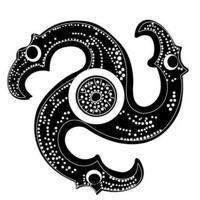
Die Herrschaft
Indoeuropean heritage, megalithism, post-christian weltanschauung, accelerationism and radical ecology. From the co-founder of Polemos and Prometheica. Contributor of Ancestral Europe and Assemblea della Lance.
نمایش بیشتر338
مشترکین
-124 ساعت
-17 روز
+430 روز
- مشترکین
- پوشش پست
- ER - نسبت تعامل
در حال بارگیری داده...
معدل نمو المشتركين
در حال بارگیری داده...
L'insediamento Longobardo di Castelseprio.
L'alba di un nuovo inizio.
❤ 9👍 1
Photo unavailableShow in Telegram
Si è tenuta ieri nella suggestiva cornice della Ra Cà du Barlich di Varese la prestigiosa prolusione di Andrea Scarabelli e Guido Pautasso su "Libertà e Potenza in Julius Evola". Il curatore della Bibligrafia di Evola e il suo massimo esegeta a livello artistico hanno infatti fatto luce su aspetti inediti poco noti ma incredibilmente profondi dell'itinerario metafisico e artistico dell'Autore italiano a cinquant'anni dalla sua scomparsa.
Il tutto rappresenta per Assemblea delle Lance un ulteriore e significativo passo avanti nella promozione culturale.
👍 7🔥 6
Immerse yourself in Wikander's meticulous research and profound analysis, brought to life through Billinge's expert translation. Whether you are a scholar, history enthusiast, or simply curious about ancient cultures, The Aryan Männerbund offers a rare exploration of early warrior brotherhoods.
👍 5❤ 3
Repost from The Chad Pastoralist: History
Photo unavailableShow in Telegram
An interesting detail from the Rök runestone comes from the line ul niruþr sibi uiauari, which commemorates a man called Sibbi of Vé who had a son at the age of ninety.
The runestone also features a battle in which twenty kings died: kunukar tuair tikir. This is considered by scholars to be the Battle of Brávellir c. 770 AD in which the Swedes from Uppland under King Sigurðr hringr fought the Gautar under the Danish king, Háraldr hilditǫnn.
If it is commemorating that battle, it is significant because Sigurðr's forces included Starkaðr, who was blessed by Woden/Óðinn according to Saxo Grammaticus' Gesta Danorum. STJ made a cool video on Starkaðr a while back.
The commemoration of Sibbi of Vé having a son at the age of ninety reminds me of the advice from Woden/Óðinn in Hávamál verse 72:
"Better to have a son than not, even if he is born late in life, even if he is born after you die. You will rarely see gravestones standing near the road that were raised for men without sons."
👍 6❤ 3
Repost from Monferrato Non Conforme
Photo unavailableShow in Telegram
«L'osservazione fondamentale riguardo alla concezione del caos in Nietzsche è la seguente: solo un pensiero del tutto privo di forza di volontà dedurrà una volontà di empietà dalla volontà di deificazione dell'ente. Al contrario, il pensiero veramente metafisico, nel punto estremo della de-deificazione, senza concedersi alcun sotterfugio e rifuggendo ogni mistificazione, scoprirà quella via sulla quale soltanto si potranno incontrare gli Dei, se mai si vorranno incontrarli nuovamente nella storia dell'umanità."
– Heidegger
👍 7❤ 3
Repost from ᛉ Sagnamaðr Stark ᛉ
The Second Merseburg Charm, which recounts Odin healing Baldr’s horse, has multiple later 18-19th Century parallels in Scandinavia, Scotland and Saxony, wherein Jesus or St. Olaf take the place of Odin, which shows this particular healing charm was widely known.
They all follow a very similar formula; always along similar lines of “bone to bone, blood to blood,” etc. and would be recited when applying bandages.
Jacob Grimm collected multiple examples from Norway, Sweden, Denmark, and the Shetland Islands. One example from Norway;
“Jesus himself rode to the heath,
And as he rode, his horse's bone was broken.
Jesus dismounted and healed that:
Jesus laid marrow to marrow,
Bone to bone, flesh to flesh.
Jesus thereafter laid a leaf
So that these should stay in their place.”
Artur Hazelius recorded one from Småland, Sweden, brazenly invoking Odin in the 19th Century.
“Odin rides over rock and hill;
He rides his horse out of dislocation and into realignment,
Out of disorder and into order, bone to bone, joint to joint,
As it was best, when it was whole.”
Book 4, hymn 12 of the Atharvaveda contains a very similar healing charm for a broken bone;
“Thou art the healer, making whole, the healer of the broken bone:
Make thou this whole, Arundhatī!
Whatever bone of thine within thy body hath been wrenched or cracked,
May Dhātar set it properly and join together limb by limb.
With marrow be the marrow joined, thy limb united with the limb.
Let what hath fallen of thy flesh, and the bone also grow again.
Let marrow close with marrow, let skin grow united with the skin.
Let blood and bone grow strong in thee, flesh grow together with the flesh.
Join thou together hair with hair, join thou together skin with skin.
Let blood and bone grow strong in thee. Unite the broken part, O Plant.
Arise, advance, speed forth; the car (chariot?) hath goodly fellies, naves, and wheels!
Stand up erect upon thy feet.
If he be torn and shattered, having fallen into a pit, or a cast stone have struck him,
Let the skilled leech join limb with limb, as 'twere the portions of a car.”
~Griffith translation
ᚬ
👍 2
یک طرح متفاوت انتخاب کنید
طرح فعلی شما تنها برای 5 کانال تجزیه و تحلیل را مجاز می کند. برای بیشتر، لطفا یک طرح دیگر انتخاب کنید.
